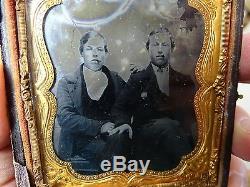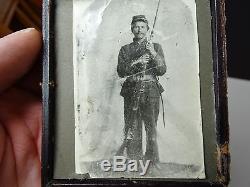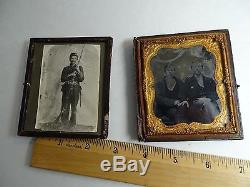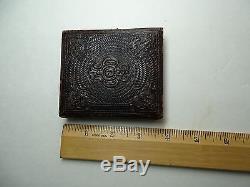Unusual Ambrotype Photo Affectionate Gay Men Hand Leg- 1860s & Civil War Soldier







& Photo of Civil War Soldier with Musket. For offer, a nice old photograph lot.
Fresh from a prominent estate in Upstate NY. Never offered on the market until now. Vintage, Old, Original, Antique, NOT a Reproduction - Guaranteed!! Amrotpye image in case showing men with cigars in mouths, one has hand on other's leg, and other man has hand on other's shoulder.
On other side of the case is an image of a Civil War soldier (looks like a photo of a photo). Case is cracked on left side edge. Please see photos for details.If you collect 19th century American history, Americana photography, fashion, culture, etc. This is a treasure you will not see again! Add this to your image or paper / ephemera collection.
Gay is a term that primarily refers to a homosexual person or the trait of being homosexual. The term was originally used to mean "carefree", "happy", or "bright and showy". The term's use as a reference to homosexuality may date as early as the late 19th century, but its use gradually increased in the 20th century. [1] In modern English, gay has come to be used as an adjective, and as a noun, referring to the people, especially to gay males, and the practices and cultures associated with homosexuality. By the end of the 20th century, the word gay was recommended by major LGBT groups and style guides to describe people attracted to members of the same sex.
[2][3] At about the same time, a new, pejorative use became prevalent in some parts of the world. In the Anglosphere, this connotation, among younger speakers, has a meaning ranging from derision e. Equivalent to rubbish or stupid to a light-hearted mockery or ridicule e. Equivalent to weak, unmanly, or lame. In this use, the word rarely means "homosexual", as it is often used, for example, to refer to an inanimate object or abstract concept of which one disapproves.
The extent to which these usages still retain connotations of homosexuality has been debated and harshly criticized. History Overview Cartoon from Punch magazine in 1857 illustrating the use of "gay" as a colloquial euphemism for being a prostitute.[6] One woman says to the other (who looks glum), How long have you been gay? The poster on the wall is for La Traviata, an opera about a courtesan. The word gay arrived in English during the 12th century from Old French gai, most likely deriving ultimately from a Germanic source.
[1] In English, the word's primary meaning was "joyful", "carefree", "bright and showy", and the word was very commonly used with this meaning in speech and literature. For example, the optimistic 1890s are still often referred to as the Gay Nineties. The title of the 1938 French ballet Gaîté Parisienne ("Parisian Gaiety"), which became the 1941 Warner Brothers movie, The Gay Parisian, [7] also illustrates this connotation. It was apparently not until the 20th century that the word began to be used to mean specifically "homosexual", although it had earlier acquired sexual connotations.
[1] The derived abstract noun gaiety remains largely free of sexual connotations and has, in the past, been used in the names of places of entertainment; for example W. Yeats heard Oscar Wilde lecture at the Gaiety Theatre in Dublin. [8] Sexualization Usage statistics from English books, according to Google Ngram Viewer. The word may have started to acquire associations of immorality as early as the 14th century, but had certainly acquired them by the 17th. [1] By the late 17th century it had acquired the specific meaning of "addicted to pleasures and dissipations", [9] an extension of its primary meaning of "carefree" implying "uninhibited by moral constraints". A gay woman was a prostitute, a gay man a womanizer, and a gay house a brothel. [1] The use of gay to mean "homosexual" was in origin merely an extension of the word's sexualized connotation of "carefree and uninhibited", which implied a willingness to disregard conventional or respectable sexual mores. Such usage, documented as early as the 1920s, was likely present before the 20th century, [1] although it was initially more commonly used to imply heterosexually unconstrained lifestyles, as in the once-common phrase "gay Lothario", [10] or in the title of the book and film The Gay Falcon (1941), which concerns a womanizing detective whose first name is "Gay". Similarly, Fred Gilbert and G. MacDermott's music hall song of the 1880s, "Charlie Dilke Upset the Milk" Master Dilke upset the milk/When taking it home to Chelsea;/ The papers say that Charlie's gay/Rather a wilful wag!Referred to Sir Charles Dilke's alleged heterosexual impropriety. [11] Giving testimony in court in 1889, the rentboy John Saul stated: I occasionally do odd-jobs for different gay people. "[12] Well into the mid 20th century a middle-aged bachelor could be described as "gay, indicating that he was unattached and therefore free, without any implication of homosexuality. This usage could apply to women too.
The British comic strip Jane, first published in the 1930s, described the adventures of Jane Gay. Far from implying homosexuality, it referred to her free-wheeling lifestyle with plenty of boyfriends (while also punning on Lady Jane Grey). A passage from Gertrude Stein's Miss Furr & Miss Skeene (1922) is possibly the first traceable published use of the word to refer to a homosexual relationship. According to Linda Wagner-Martin Favored Strangers: Gertrude Stein and her Family (1995) the portrait "featured the sly repetition of the word gay, used with sexual intent for one of the first times in linguistic history, " and Edmund Wilson 1951, quoted by James Mellow in Charmed Circle (1974) agreed.
[13] For example: They were... Gay, they learned little things that are things in being gay... They were quite regularly gay.
Gertrude Stein, 1922 Bringing Up Baby (1938) was the first film to use the word gay in apparent reference to homosexuality. In a scene in which the Cary Grant character's clothes have been sent to the cleaners, he is forced to wear a womans feather-trimmed robe. When another character asks about his robe, he responds, Because I just went gay all of a sudden!
" Since this was a mainstream film at a time when the use of the word to refer to cross-dressing (and, by extension, homosexuality) would still be unfamiliar to most film-goers, the line can also be interpreted to mean, "I just decided to do something frivolous. "[14] The word continued to be used with the dominant meaning of "carefree, as evidenced by the title of The Gay Divorcee (1934), a musical film about a heterosexual couple.
Shift to homosexual By the mid-20th century, gay was well established in reference to hedonistic and uninhibited lifestyles[9] and its antonym straight, which had long had connotations of seriousness, respectability, and conventionality, had now acquired specific connotations of heterosexuality. [15] In the case of gay, other connotations of frivolousness and showiness in dress ("gay apparel") led to association with camp and effeminacy. This association no doubt helped the gradual narrowing in scope of the term towards its current dominant meaning, which was at first confined to subcultures. Gay was the preferred term since other terms, such as queer, were felt to be derogatory. [16] Homosexual is perceived as excessively clinical, [17][18][19] since the sexual orientation now commonly referred to as "homosexuality" was at that time a mental illness diagnosis in the Diagnostic and Statistical Manual of Mental Disorders (DSM). In mid-20th century Britain, where male homosexuality was illegal until the Sexual Offences Act 1967, to openly identify someone as homosexual was considered very offensive and an accusation of serious criminal activity. Additionally, none of the words describing any aspect of homosexuality were considered suitable for polite society. Consequently, a number of euphemisms were used to hint at suspected homosexuality. Examples include "sporty" girls and "artistic" boys, [20] all with the stress deliberately on the otherwise completely innocent adjective. The sixties marked the transition in the predominant meaning of the word gay from that of "carefree" to the current "homosexual". In the British comedy-drama film Light Up the Sky! (1960), directed by Lewis Gilbert, about the antics of a British Army searchlight squad during World War II, there is a scene in the mess hut where the character played by Benny Hill proposes an after-dinner toast. He begins, I'd like to propose..." at which point a fellow diner, played by Sidney Tafler, interjects "Who to? , suggesting a proposal of marriage. The Benny Hill character responds, "Not to you for start, you ain't my type". He then adds in mock doubt, Oh, I don't know, you're rather gay on the quiet.
By 1963, a new sense of the word gay was known well enough to be used by Albert Ellis in his book The Intelligent Woman's Guide to Man-Hunting. In his 1964 novel Last Exit to Brooklyn, could write that a character took pride in being a homosexual by feeling intellectually and esthetically superior to those (especially women) who weren't gay.... "[21] Later examples of the original meaning of the word being used in popular culture include the theme song to the 19601966 animated TV series The Flintstones, whereby viewers are assured that they will "have a gay old time.
" Similarly, the 1966 Herman's Hermits song "No Milk Today, which became a Top 10 hit in the UK and a Top 40 hit in the U. Included the lyric No milk today, it was not always so / The company was gay, we'd turn night into day. [22] In June 1967, the headline of the review of the Beatles' Sgt. Pepper's Lonely Hearts Club Band album in the British daily newspaper The Times stated, "The Beatles revive hopes of progress in pop music with their gay new LP". [23] Yet in the same year, The Kinks recorded "David Watts".
[24] Ostensibly about schoolboy envy, the song also operated as an in-joke, as related in Jon Savage's "The Kinks: The Official Biography", because the song took its name from a homosexual promoter they'd encountered who'd had romantic designs on songwriter Ray Davies' teenage brother; and the lines "he is so gay and fancy free" attest to the ambiguity of the word's meaning at that time, with the second meaning evident only for those in the know. [25] As late as 1970, the first episode of The Mary Tyler Moore Show has the demonstrably straight Mary Richards' downstairs neighbor, Phyllis, breezily declaiming that Mary is, at age 30, still young and gay. There is little doubt that the homosexual sense is a development of the word's traditional meaning, as described above. It has nevertheless been claimed that gay stands for "Good As You", but there is no evidence for this: it is a backronym created as popular etymology.[26] Homosexuality Main article: Homosexuality Sexual orientation Male and female symbols overlaid Sexual orientations Asexual Bisexual Heterosexual Homosexual Non-binary categories Androphilia and gynephilia Gray asexuality Non-heterosexual Pansexuality Polysexuality Queer Research Biological Human female sexuality Human male sexuality Demographics Environment Hetero/homosexual continuum Kinsey scale Klein Grid Neuroscientific Queer studies Romantic orientation Sexology Timeline of sexual orientation and medicine Non-human animals Animal sexual behaviour Non-reproductive sexual behavior in animals Homosexual behavior in animals (list) Category Category v t e The rainbow flag is a symbol of gay pride. Sexual orientation, identity, behavior Main articles: Sexual orientation, Sexual identity, and Human sexual behavior See also: Situational sexual behavior The American Psychological Association defines sexual orientation as "an enduring pattern of emotional, romantic, and/or sexual attractions to men, women, or both sexes, " ranging along a continuum, from exclusive attraction to the other sex to exclusive attraction to the same sex. "[27] Sexual orientation can also be "discussed in terms of three categories: heterosexual (having emotional, romantic, or sexual attractions to members of the other sex), gay/lesbian (having emotional, romantic, or sexual attractions to members of one's own sex), and bisexual (having emotional, romantic, or sexual attractions to both men and women). "[27] According to Rosario, Schrimshaw, Hunter, Braun (2006), "the development of a lesbian, gay, or bisexual (LGB) sexual identity is a complex and often difficult process. Unlike members of other minority groups e.
Ethnic and racial minorities, most LGB individuals are not raised in a community of similar others from whom they learn about their identity and who reinforce and support that identity. Rather, LGB individuals are often raised in communities that are either ignorant of or openly hostile toward homosexuality. "[28] The British gay rights activist Peter Tatchell has argued that the term gay is merely a cultural expression which reflects the current status of homosexuality within a given society, and claiming that "Queer, gay, homosexual...
In the long view, they are all just temporary identities. One day, we will not need them at all.
[29] If a person engages in sexual activity with a partner of the same sex but does not self-identify as gay, terms such as'closeted','discreet', or'bi-curious' may apply. Conversely, a person may identify as gay without having had sex with a same-sex partner.
Possible choices include identifying as gay socially while choosing to be celibate or while anticipating a first homosexual experience. Further, a bisexual person can also identify as "gay" but others might consider gay and bisexual to be mutually exclusive. There are some who are drawn to the same sex but neither engage in sexual activity nor identify as gay; these could have the term asexual applied, even though asexual generally can mean no attraction or involve heterosexual attraction but no sexual activity.
Terminology Main article: Terminology of homosexuality Some reject the term homosexual as an identity-label because they find it too clinical-sounding;[18][19][30] they believe it is too focused on physical acts rather than romance or attraction, or too reminiscent of the era when homosexuality was considered a mental illness. Conversely, some reject term gay as an identity-label because they perceive the cultural connotations to be undesirable or because of the negative connotations of the slang usage of the word.
Style guides, like the following from the Associated Press, call for gay over homosexual: Gay: Used to describe men and women attracted to the same sex, though lesbian is the more common term for women. Preferred over homosexual except in clinical contexts or references to sexual activity. LGBT community Main article: LGBT community Starting in the mid-1980s in the United States, a conscious effort was under way within what was then only called the gay community, to add the term lesbian to the name of all gay organizations that catered to both male and female homosexuals, and to use the terminology of gay and lesbian, or lesbian/gay when referring to that community.
So, organizations like the National Gay Task Force became the National Gay and Lesbian Task Force. For many ardent feminist lesbians, it was also important that the L come first, lest an L following a G become another symbol of male dominance over women, [32] although other women prefer the usage gay woman. In the 1990s, this was followed by another equally concerted push to include the terminology specifically pointing out the inclusion of bisexual, transgender, intersex, and other people, reflecting the intra-community debate as to whether these other sexual minorities were part of the same human rights movement. Most news organizations have formally adopted variations of this use, following the example and preference of the organizations, as reflected in their press releases and public communications.
Descriptor A gay bar in Seattle, United States. The term gay can also be used as an adjective to describe things related to homosexual men, or things which are part of the said culture.
For example, the term "gay bar" describes the bar which either caters primarily to a homosexual male clientele, or is otherwise part of homosexual male culture. Using it to describe an object, such as an item of clothing, suggests that it is particularly flamboyant, often on the verge of being gaudy and garish. This usage predates the association of the term with homosexuality, but has acquired different connotations since the modern usage developed. Use as a noun The label "gay" was originally used purely as an adjective ("he is a gay man" or "he is gay"). The term has also been in use as a noun with the meaning "homosexual man" since the 1970s, as in "gays are opposed to that policy".
This usage is common, such as in the case of "LGBT" (lesbian, gay, bisexual, and transgender), and in the names of organizations, such as Parents, Families and Friends of Lesbians and Gays (PFLAG) and Children Of Lesbians And Gays Everywhere (COLAGE). It is sometimes used to refer to individuals, as in "he is a gay" or "two gays were there too", although this may be perceived as derogatory. [33] It was also used to comic effect by the Little Britain character Dafydd Thomas.
Generalized pejorative use When used with a derisive attitude e. "That was so gay", the word gay is pejorative. While retaining its other meanings, its use among young people as a general term of disparagement is common. [4][34] This pejorative usage has its origins in the late 1970s. Beginning in the 1980s and especially in the late 1990s, the usage as a generic insult became common among young people.[4] This usage of the word has been criticized as homophobic. A 2006 BBC ruling by the Board of Governors over the use of the word in this context by Chris Moyles on his Radio 1 show, "I do not want that one, it's gay, " advises "caution on its use" for this reason: The word'gay', in addition to being used to mean'homosexual' or'carefree', was often now used to mean'lame' or'rubbish'.
This is a widespread current usage of the word amongst young people... The governors said, however, that Moyles was simply keeping up with developments in English usage. Was familiar with hearing this word in this context. The governors believed that in describing a ring tone as'gay', the DJ was conveying that he thought it was'rubbish', rather than'homosexual'. The panel acknowledged however that this use...
Could cause offence in some listeners, and counselled caution on its use. BBC Board of Governors, [34] The BBC's ruling was heavily criticised by the Minister for Children, Kevin Brennan, who stated in response that "the casual use of homophobic language by mainstream radio DJs" is: too often seen as harmless banter instead of the offensive insult that it really represents. To ignore this problem is to collude in it. The blind eye to casual name-calling, looking the other way because it is the easy option, is simply intolerable. "[35] Shortly after the Moyles incident a campaign against homophobia was launched in Britain under the slogan "homophobia is gay", playing on the double meaning of the word "gay in youth culture. [36] In a 2013 article published in the Journal of Interpersonal Violence, University of Michigan researchers Michael R. Woodford, Alex Kulick and Perry Silverschanz alongside Appalachian State University professor Michael L. Howell, argued that the pejorative use of the word "gay" was a microagression. [37] Their research found that college-age men were more likely to repeat the word pejoratively if their friends said it, while they were less likely to say it if they had lesbian, gay or bisexual peers.[37] Parallels in other languages The concept of a "gay identity" and the use of the term gay may not be used or understood the same way in non-Westernised cultures, since modes of sexuality may differ from those prevalent in the West. [38] The German equivalent for gay, schwul, which is etymologically derived from schwül (hot, humid), also acquired the pejorative meaning within youth culture. [39] See also LGBT portal Anti-LGBT slogans Deviance (sociology) Gay bashing Gay sexual practices Gender identity Gay gene (Xq28) Gender dysphoria Hate speech Heterosexism Human male sexuality Human Rights Campaign Labeling theory LGBT rights opposition LGBT themes in mythology List of gay, lesbian or bisexual people National Gay and Lesbian Task Force Religion and sexuality Sexuality and gender identity-based cultures Stigma.
The item "Unusual Ambrotype Photo Affectionate Gay Men Hand Leg- 1860s & Civil War Soldier" is in sale since Friday, February 17, 2017. This item is in the category "Collectibles\Photographic Images\Vintage & Antique (Pre-1940)\Ambrotypes".
The seller is "dalebooks" and is located in Rochester, New York. This item can be shipped worldwide.
- Color: Black & White
- Photo Type: Ambrotype
- Original/Reprint: Original Print
- Listed By: Dealer or Reseller
- Country/Region of Manufacture: United States
- Size Type/Largest Dimension: Small (Up to 7")
- Date of Creation: 1860-1869
- Subject: Figures & Portraits
- Framing: Matted & Framed
- Region of Origin: US

